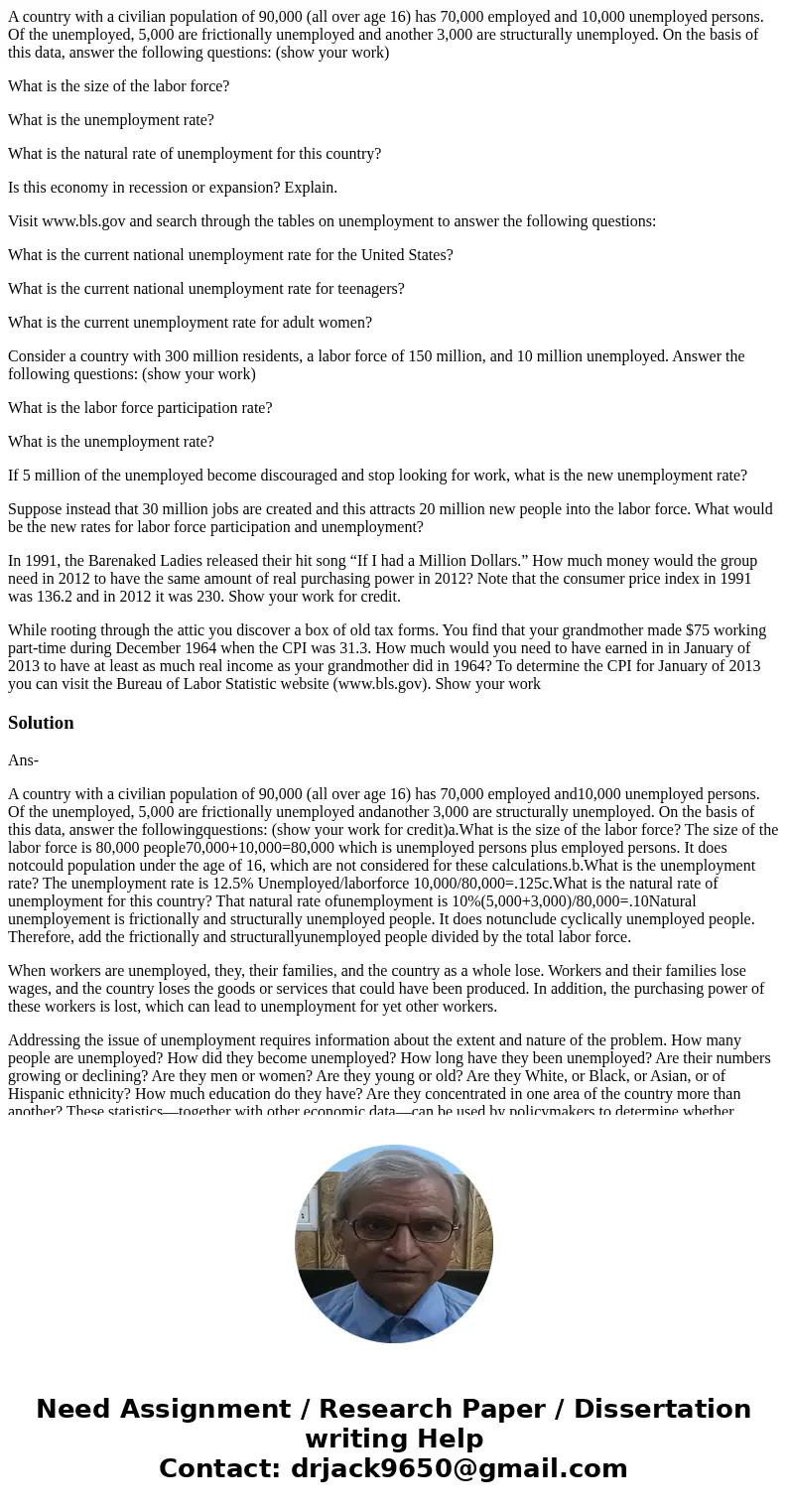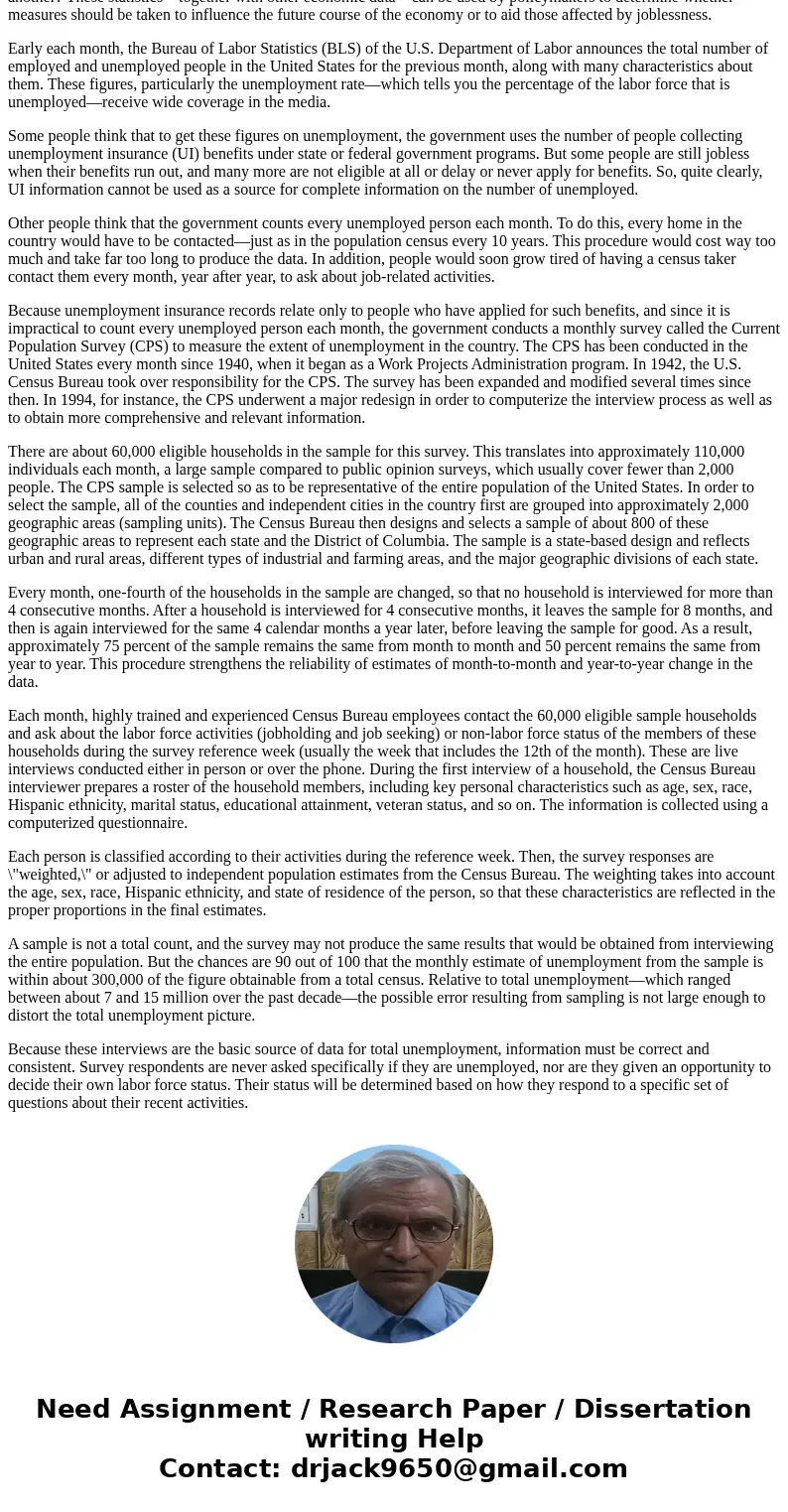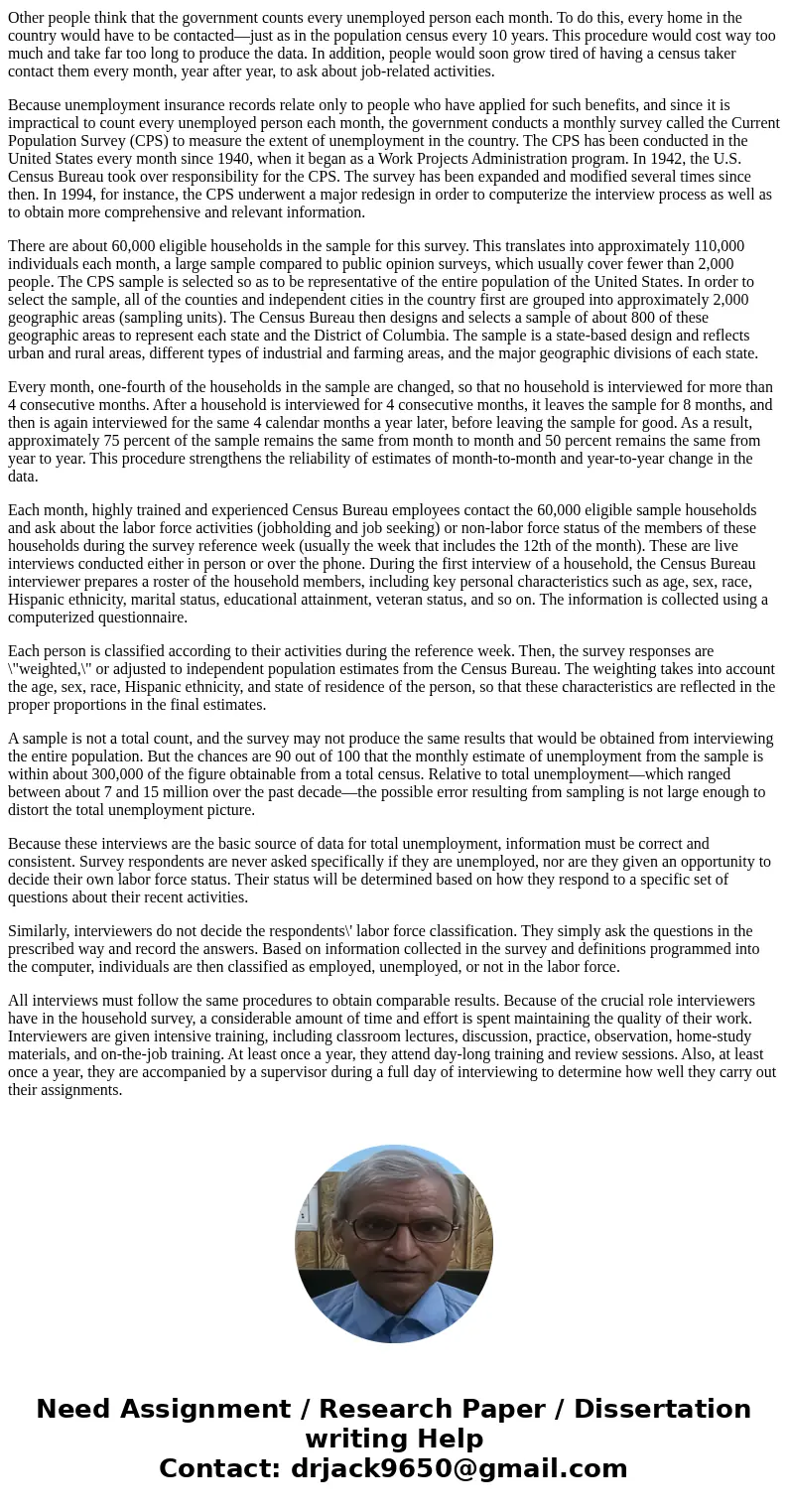A country with a civilian population of 90000 all over age 1
A country with a civilian population of 90,000 (all over age 16) has 70,000 employed and 10,000 unemployed persons. Of the unemployed, 5,000 are frictionally unemployed and another 3,000 are structurally unemployed. On the basis of this data, answer the following questions: (show your work)
What is the size of the labor force?
What is the unemployment rate?
What is the natural rate of unemployment for this country?
Is this economy in recession or expansion? Explain.
Visit www.bls.gov and search through the tables on unemployment to answer the following questions:
What is the current national unemployment rate for the United States?
What is the current national unemployment rate for teenagers?
What is the current unemployment rate for adult women?
Consider a country with 300 million residents, a labor force of 150 million, and 10 million unemployed. Answer the following questions: (show your work)
What is the labor force participation rate?
What is the unemployment rate?
If 5 million of the unemployed become discouraged and stop looking for work, what is the new unemployment rate?
Suppose instead that 30 million jobs are created and this attracts 20 million new people into the labor force. What would be the new rates for labor force participation and unemployment?
In 1991, the Barenaked Ladies released their hit song “If I had a Million Dollars.” How much money would the group need in 2012 to have the same amount of real purchasing power in 2012? Note that the consumer price index in 1991 was 136.2 and in 2012 it was 230. Show your work for credit.
While rooting through the attic you discover a box of old tax forms. You find that your grandmother made $75 working part-time during December 1964 when the CPI was 31.3. How much would you need to have earned in in January of 2013 to have at least as much real income as your grandmother did in 1964? To determine the CPI for January of 2013 you can visit the Bureau of Labor Statistic website (www.bls.gov). Show your work
Solution
Ans-
A country with a civilian population of 90,000 (all over age 16) has 70,000 employed and10,000 unemployed persons. Of the unemployed, 5,000 are frictionally unemployed andanother 3,000 are structurally unemployed. On the basis of this data, answer the followingquestions: (show your work for credit)a.What is the size of the labor force? The size of the labor force is 80,000 people70,000+10,000=80,000 which is unemployed persons plus employed persons. It does notcould population under the age of 16, which are not considered for these calculations.b.What is the unemployment rate? The unemployment rate is 12.5% Unemployed/laborforce 10,000/80,000=.125c.What is the natural rate of unemployment for this country? That natural rate ofunemployment is 10%(5,000+3,000)/80,000=.10Natural unemployement is frictionally and structurally unemployed people. It does notunclude cyclically unemployed people. Therefore, add the frictionally and structurallyunemployed people divided by the total labor force.
When workers are unemployed, they, their families, and the country as a whole lose. Workers and their families lose wages, and the country loses the goods or services that could have been produced. In addition, the purchasing power of these workers is lost, which can lead to unemployment for yet other workers.
Addressing the issue of unemployment requires information about the extent and nature of the problem. How many people are unemployed? How did they become unemployed? How long have they been unemployed? Are their numbers growing or declining? Are they men or women? Are they young or old? Are they White, or Black, or Asian, or of Hispanic ethnicity? How much education do they have? Are they concentrated in one area of the country more than another? These statistics—together with other economic data—can be used by policymakers to determine whether measures should be taken to influence the future course of the economy or to aid those affected by joblessness.
Early each month, the Bureau of Labor Statistics (BLS) of the U.S. Department of Labor announces the total number of employed and unemployed people in the United States for the previous month, along with many characteristics about them. These figures, particularly the unemployment rate—which tells you the percentage of the labor force that is unemployed—receive wide coverage in the media.
Some people think that to get these figures on unemployment, the government uses the number of people collecting unemployment insurance (UI) benefits under state or federal government programs. But some people are still jobless when their benefits run out, and many more are not eligible at all or delay or never apply for benefits. So, quite clearly, UI information cannot be used as a source for complete information on the number of unemployed.
Other people think that the government counts every unemployed person each month. To do this, every home in the country would have to be contacted—just as in the population census every 10 years. This procedure would cost way too much and take far too long to produce the data. In addition, people would soon grow tired of having a census taker contact them every month, year after year, to ask about job-related activities.
Because unemployment insurance records relate only to people who have applied for such benefits, and since it is impractical to count every unemployed person each month, the government conducts a monthly survey called the Current Population Survey (CPS) to measure the extent of unemployment in the country. The CPS has been conducted in the United States every month since 1940, when it began as a Work Projects Administration program. In 1942, the U.S. Census Bureau took over responsibility for the CPS. The survey has been expanded and modified several times since then. In 1994, for instance, the CPS underwent a major redesign in order to computerize the interview process as well as to obtain more comprehensive and relevant information.
There are about 60,000 eligible households in the sample for this survey. This translates into approximately 110,000 individuals each month, a large sample compared to public opinion surveys, which usually cover fewer than 2,000 people. The CPS sample is selected so as to be representative of the entire population of the United States. In order to select the sample, all of the counties and independent cities in the country first are grouped into approximately 2,000 geographic areas (sampling units). The Census Bureau then designs and selects a sample of about 800 of these geographic areas to represent each state and the District of Columbia. The sample is a state-based design and reflects urban and rural areas, different types of industrial and farming areas, and the major geographic divisions of each state.
Every month, one-fourth of the households in the sample are changed, so that no household is interviewed for more than 4 consecutive months. After a household is interviewed for 4 consecutive months, it leaves the sample for 8 months, and then is again interviewed for the same 4 calendar months a year later, before leaving the sample for good. As a result, approximately 75 percent of the sample remains the same from month to month and 50 percent remains the same from year to year. This procedure strengthens the reliability of estimates of month-to-month and year-to-year change in the data.
Each month, highly trained and experienced Census Bureau employees contact the 60,000 eligible sample households and ask about the labor force activities (jobholding and job seeking) or non-labor force status of the members of these households during the survey reference week (usually the week that includes the 12th of the month). These are live interviews conducted either in person or over the phone. During the first interview of a household, the Census Bureau interviewer prepares a roster of the household members, including key personal characteristics such as age, sex, race, Hispanic ethnicity, marital status, educational attainment, veteran status, and so on. The information is collected using a computerized questionnaire.
Each person is classified according to their activities during the reference week. Then, the survey responses are \"weighted,\" or adjusted to independent population estimates from the Census Bureau. The weighting takes into account the age, sex, race, Hispanic ethnicity, and state of residence of the person, so that these characteristics are reflected in the proper proportions in the final estimates.
A sample is not a total count, and the survey may not produce the same results that would be obtained from interviewing the entire population. But the chances are 90 out of 100 that the monthly estimate of unemployment from the sample is within about 300,000 of the figure obtainable from a total census. Relative to total unemployment—which ranged between about 7 and 15 million over the past decade—the possible error resulting from sampling is not large enough to distort the total unemployment picture.
Because these interviews are the basic source of data for total unemployment, information must be correct and consistent. Survey respondents are never asked specifically if they are unemployed, nor are they given an opportunity to decide their own labor force status. Their status will be determined based on how they respond to a specific set of questions about their recent activities.
Similarly, interviewers do not decide the respondents\' labor force classification. They simply ask the questions in the prescribed way and record the answers. Based on information collected in the survey and definitions programmed into the computer, individuals are then classified as employed, unemployed, or not in the labor force.
All interviews must follow the same procedures to obtain comparable results. Because of the crucial role interviewers have in the household survey, a considerable amount of time and effort is spent maintaining the quality of their work. Interviewers are given intensive training, including classroom lectures, discussion, practice, observation, home-study materials, and on-the-job training. At least once a year, they attend day-long training and review sessions. Also, at least once a year, they are accompanied by a supervisor during a full day of interviewing to determine how well they carry out their assignments.



 Homework Sourse
Homework Sourse